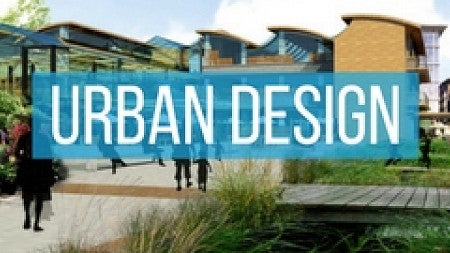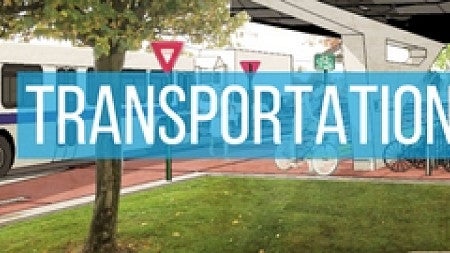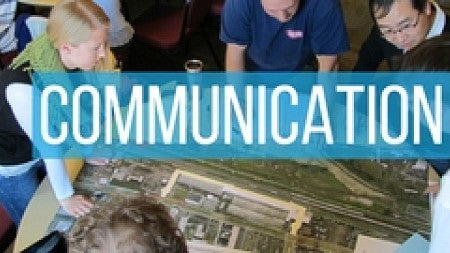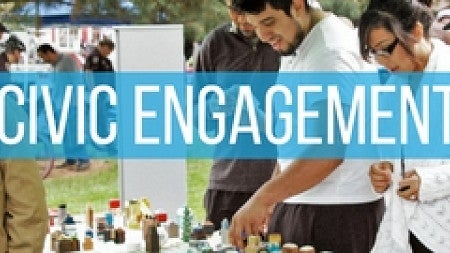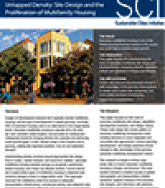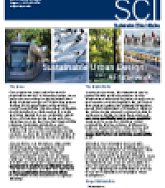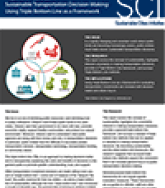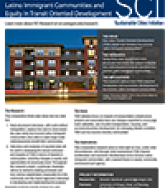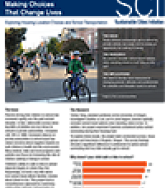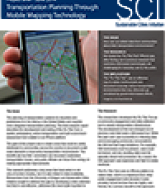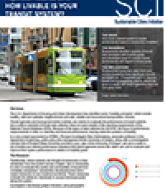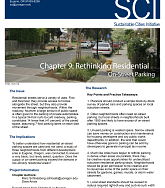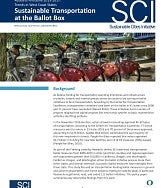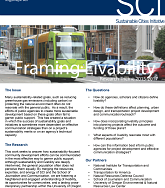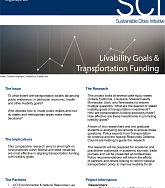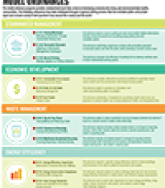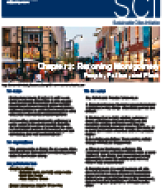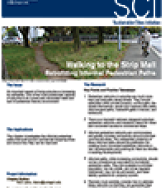Urban Design
Untapped Density: Site Design and the Proliferation of Multifamily Housing
Nico Larco, AIA: nlarco@uoregon.edu
Suburban multifamily housing is one of the fastest growing housing markets in the country and could help to achieve smart growth. This paper focuses on understanding the roots of suburban multifamily site design and development by comparing specific regulation, culture, and practices in Oregon and Arizona. Current planning and development should take advantage of this growing housing trend to create more livable, less congested, and multi-modal suburban communities. Download the brief.
Sustainable Urban Design — A FrameworkNico Larco, AIA: nlarco@uoregon.edu |
Urban design is defined by the researcher as the process, design, and organization of urban form and uses, including the design of public space, transportation systems, and open space. Urban design development is complex to research, as development opportunities and constraints can vary greatly depending on the disciplinary lens used when approaching the project. The researcher proposes the following overarching framework for sustainable urban design as a baseline for weighing these trade-offs and aiding in identifying where a single design decision can accomplish synergistic goals. Download the brief.
Sustainable Transportation Decision-Making: Using Triple Bottom Line as a FrameworkRobert Zako, Ph.D., rzako@uoregon.edu and Terry Moore, FAICP |
In a rapidly changing and uncertain world where public funds are becoming increasingly scarce, public entities must make sound, sustainable transportation decisions. This report reviews the concept of sustainability, highlights inherent uncertainty in making transportation decisions, provides a Triple Bottom Line framework, and surveys Triple Bottom Line methods. The research team concluded that using Triple Bottom Line as a framework for evaluating transportation investments can increase both decision-maker and citizen buy-in. Download the brief.
Transportation
Transit Oriented Development (TOD) and low-income Latino CommunitiesGerardo Sandoval, gsando@uoregon.edu |
This research analyzed the implications of how Transit Oriented Development impacts and revitalizes low-income Latino immigrant communities. Using three case studies; TOD in MacArthur Park in Los Angeles centered around a new subway station, the Fruitvale Transit Village in Oakland and the station in Hillsboro, Oregon, in addition to semi- structured interviews, a general consensus of benefits involving revitalization around existing light rail stations were cataloged. Each project studied deomonstrated the drive to increase economic development and revitalization of the immigrant low-income Latino communities. What are the process lessons we can learn from communities that have experienced this change? Download the brief.
Making Choices That Change Lives: Exploring Housing Location Choices and School TransportationYizhao Yang, Ph.D., yizhao@uoregon.edu |
Do parents consider school travel options when deciding where to live? Why or why not? This project investigated whether or not, and to what degree, parents explicitly consider school travel options when deciding where to live. In addition, the project examined if parents considered active school commuting during their housing hunt. This study shows that active commuting preferences influence later travel behavior through residential location choice. More resources need to be devoted to changing parents’ attitudes and preferences for walkable and bikeable routes to school. Download the brief.
Transportation Planning Through Mobile Mapping TechnologyMarc Schlossberg, Ph.D., schlossb@uoregon.edu |
How can we collect data from communities about their transportation environments? This study tested the “Fix This Tool” iPhone app, after finding out in previous research that restrictive GIS-based technologies are challenging for everyday use by the public. The “Fix This Tool” was an effective way to easily communicate and document everyday active-transportation environments that may otherwise go unnoticed by government-based efforts. Download the brief.
Livability Performance Metrics for TransitMarc Schlossberg, Ph.D, Justin Carinci, schlossb@uoregon.edu |
How does a transit system's overall performance impact a community's livability? Transit agencies and local governments routinely use metrics to evaluate the performance of transit systems, but a uniform standard of transit data collection does not exist outside of the reporting requirements of the National Transit Database (NTD). In a new project sponsored by OTREC, this project seeks to create standards of tested and refined performance indicators that transit agencies across the nation can use to evaluate and improve their system performance in relation to livability goals. Download the brief.
Assessing State Efforts to Integrate Transportation, Land Use and ClimateRebecca Lewis, Ph.D, rlewis9@uoregon.edu and Rob Zako, Ph.D, rzako@uoregon.edu |
This project looks at how four case study states—California, Oregon, Washington and Maryland—are working to reduce GHGs from the transportation sector, with a focus on efforts to reduce vehicle miles traveled per capita. By promoting alternative modes of transportation and limiting developmental sprawl, the reduction of vehicle miles traveled will reduce greenhouse gas emissions. Download the brief.
Chapter 9: Rethinking Residential On-Street ParkingMarc Schlossberg, schlossb@uoregon.edu and Dave Amos |
To better understand how residential on-street parking spaces are used and not used, a study of three neighborhoods from different development eras in Eugene, Oregon, was conducted to answer a very basic, but rarely asked, question: Does the supply of on-street parking exceed the demand in low-density residential areas? Download the brief.
Communication
Sustainable Transportation at the Ballot BoxRebecca Lewis, Ph.D, rlewis9@uoregon.edu, Tyce Herman and Matthew Bean |
As part of the Framing Livability Research theme, SCI examined transportation ballot measures from 2005-2015 in cities (and their counties and regional agencies) with populations greater than 100,000 in California, Oregon, and Washington. California, Oregon, and Washington utilize the ballot initiative process more than other states, and several extensive, successful ballot measures have emerged from these state. This study focused on transportation funding ballot measures in general and active transportation and transit projects relating to livability goals in particular. Researchers gathered, read, and coded 111 ballot initiatives. This policy paper summarizes key descriptive findings from this work. File Download the brief.
Framing LivabilityNico Larco, AIA nlarco@uoregon.edu, Rebecca Lewis, Ph.D, rlewis9@uoregon.edu |
This work seeks to answer how sustainability-focused community development efforts can be communicated in the most effective way to garner public support. Although sustainability and livability are deeply intertwined, the general population often does not perceive them equally. By merging the resources, expertise, and energy of SCI and the School of Journalism and Communication, we are fostering a heightened and engaged understanding of livability, its opportunities for communities, and a lasting cross-disciplinary partnership within the University of Oregon. Download the brief.
Livability Goals & Transportation FundingRebecca Lewis, Ph.D, rlewis9@uoregon.edu and Rob Zako, Ph.D, rzako@uoregon.edu |
This project looks at several case study states (initially California, Louisiana, Massachusetts, Minnesota, Utah, and Tennessee) and how transportation dollars are advancing public endeavors, in particular, economic, health and other livability goals. This comparative research aims to shed light on what practices within federal and state initiatives are most effective in aligning transporation funding with livability goals. Download the brief.
Civic Engagement
Community Resilience Project: Model OrdinancesJonathan Rosenbloom, jonathan.rosenbloom@drake.edu |
The Community Resilience Project was done in collaboration with Drake University Law School and Greater Des Moines Partnership previously to Jonathan's involvement with SCI at University of Oregon. Jonathan's current collaboration with the SCYP program in Redmond, OR is working on producing a similar comprehensive document. The model ordinances provide standardized local laws aimed at developing economically strong and environmentally healthy communities. The following ordinances have been developed through a rigorous vetting process that has included public and private input and a broad survey of best practices from around the country and the world. Download the brief.
Chapter 3: Rezoning Montgomery: People, Politics, and PlaceGerrit-Jan Knaap, Aviva Hokins Brown, Rebecca Lewis, Ph.D., rlewis9@uoregon.edu |
Montgomery County, Maryland is well known for its progressive approaches to land use and development pattern. This chapter seeks to display the processes, trials, and tribulations that occur when reforming zoning codes in a suburban county. Download the brief.
Chapter 8: Walking to the Strip Mall: Retrofitting Informal Pedestrian PathsNico Larco, AIA, nlarco@uoregon.edu |
This chapter investigates the informal pedestrian paths that exist around commercial shopping strips and shows how they can be improved. Download the brief.

